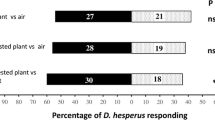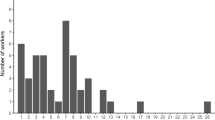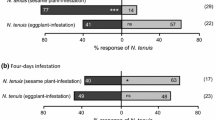Abstract
Entomophagous insects are often repelled by the secondary compounds of the plants eaten by their prey. These compounds, therefore, take on a defensive role for the phytophagous species that sequester them. Given that numerous entomophagous species are capable of learning, the effects on the foraging behavior of a repeated experience were investigated in the predatory ant Myrmica rubra. The sulfur amino acids methyl-cysteine sulfoxide (MCSO) and propyl-cysteine sulfoxide (PCSO) produced by Allium plants were identified in caterpillars of the leek moth Acrolepiopsis assectella. Three behavioral studies were carried out, with or without prior familiarization with caterpillars reared either on leek or on an artificial diet containing no Allium compounds. In choice tests with the two types of caterpillars, unfamiliarized ants displayed a preference for caterpillars reared on the artificial diet, but this preference disappeared or was reversed in both young and old ants after familiarization.
Similar content being viewed by others
REFERENCES
Arnault, C. 1979. Influence de substances de la plante-hôte sur le d´eveloppement larvaire d'Acrolepiopsis assectella (Lepidoptera; Acrolepiidae) en alimentation artificielle. Entomol. Exp. Appl. 25:64–74.
Auger, J. and Thibout, E. 1981. Émission par le poireau, Allium porrum, de thiosulfinates actifs sur la teigne du poireau, Acrolepiopsis assectella Z. (Lepidoptera). C.R. Acad. Sci. D Paris 29:217–220.
Auger, J., Melouki, F., Vannereau, A., Boscher, J., Cosson, L., and Mandon, N. 1993. Analysis of Allium sulphur amino acids by HPLC, after derivatization. Chromatographia-36:347–350.
Beckers, R., Lachaud, J. P., and Fresneau, D. 1994. The influence of olfactory conditioning on food preference in the ant Lasius niger (L.). Ethol. Ecol. Evol. 6:159–167. PREDATORY BEHAVIOR OF M. rubra 2313
Bernays, E. A. 1989. Host range in phytophagous insects: the potential role of generalist predators. Evol. Ecol. 3:299–311.
Bernays, E. A. and Cornelius, M. L. 1989. Generalist caterpillar prey are more palatable than specialists for the generalist predator Iridomymex humilis. Oecologia 79:427–430.
Bidlingmeyer, B. A., Cohen, S. A., and Tarvin, T. L. 1984. Rapid analysis of amino acids using pre-column derivatization. J. Chromatogr. A 336:93–104.
Bjorkman, C. and Larsson, S. 1991. Pine sawfly defence and variation in host plant resin acids: a trade-off with growth. Ecol. Entomol. 16:283–280.
Boscher, J., Auger, J., Mandon, N., and Ferary, S. 1995. Qualitative and quantitative comparison of volatile sulphides and flavour precursors in different organs of some wild and cultivated garlic. Biochem. Syst. Ecol. 23:787–791.
Camara, M.D. 1997. Predator responses to sequestered plant toxins buckeye caterpillars: are tritrophic interactions locally variable? J. Chem. Ecol. 23:2093–2106.
Dejean, A. 1988. Memory effect on predatory behaviour of Odontomachus troglodytes (Formicidae-Ponerinae). Behaviour 107:131–137.
Dejean, A., Corbara, B., and Oliva-rivera, J. 1990. Mise en évidence d'une forme d'apprentissage dans le comportement de capture des proies chez Pachycondyla (D Neoponera) villosa (Formicidae, Ponerinae). Behaviour 115:175–187.
Dyer, L. A. 1995. Tasty generalists and nasty specialists? Antipredator mechanisms in tropical Lepidopteran larvae. Ecology 76:1483–1496.
Dyer, L. E. and Bowers, M. D. 1996. The importance of sequestered iridoid glycosides as a defense against an ant predator. J. Chem. Ecol. 22:1527–1539.
Elmes, G.W. and Keller, L. 1993. Distribution and ecology of queen number in ants of the genus Myrmica, pp. 294–307, in L. Keller (ed.), Queen Number and Sociality in Insects. Oxford University Press.
FÉrary, S., Keller, J., Boscher, J., and Auger, J. 1998. Fast narrow-bore HPLC-DAD analysis of biologically active thiosulfinates obtained without solvent from wild Allium species. Biomed. Chromatogr. 12:104–106.
FourcassiÉ, V. and Traniello, J. F. A. 1993. Effects of experience on food-searching behavior in the Formica schaufussi (Hymenoptera: Formicidae). J. Insect Behav. 6:287–299.
Freeman, G. G. and Whenham, R. J. 1975. A survey of volatile components of some Allium species in terms of S-alk(en)yl-L-cysteine sulfoxides present as flavour precursors. J. Sci. food Agric. 26:1869–1886.
Hare, J. F. and Eisner, T. 1993. Pyrrolizidine alkaloid deters ant predators of Utetheisa ornatix eggs: effect of alkaloid concentration, and prior exposures of ants to alkaloid-laden prey. Oecologia 96:9–18.
Jaisson, P. 1975. L'impr´egnation dans l'ontogenèse des comportements de soins aux cocoons chez la jeune fourmi rousse (Formica polyctena Forst.). Behaviour 52:1–37.
Jaisson, P. 1980. Environmental preference induced experimentally in ants (Hymenoptera: Formicidae). Nature 286:388–389.
Lancaster, J. E., Mc Callion, B. J., and Shaw, M. L. 1984. The levels of S-alk(en)yl-L-cysteine sulfoxides during the growth of the onion (Allium cepa L.). J. Sci. Food Agric. 35:415–420.
Le Roux, G., Le Roux, A. M., and Boulay, R. 1997. Apprentissage et mémorisation lors du déménagement du couvain chez Myrmica ruginodis Nyl. (Formicidae): influence de l'âge, pp. 369-373, in Actes 29éme Coll. SFECA, Albi, Publication Universit´e Paul Sabatier, Toulouse, France.
Montllor, C. B., Bernays, E. A., and Cornelius, M. L. 1991. Responses of two Hymenopteran predators to surface chemistry of their prey: significance for an alkaloid-sequestering caterpillar. J. Chem. Ecol. 17:391–399. 2314 LE ROUX, LE ROUX, AND THIBOUT
Nowbahari, B. and Thibout, E. 1992. Defensive role of Allium sulphur compounds for leek moth Acrolepiopsis assectella Z. (Lepidoptera) against generalist predators. J. Chem. Ecol. 18:1991–2002.
Schumann, R. D. and Buschinger, A. 1994. Imprinting effects on host-selection behaviour of colonyfounding Chalepoxenus muellerianus (Finzi) females (Hymenoptera, Formicidae). Ethology 97:33–46.
traugott, M. S. and Stamp, N. E. 1996. Effects of chlorogenic acid-and tomatine-fed caterpillars on the behavior of an insect predator. J. Insect Behav. 9:461–476.
Author information
Authors and Affiliations
Corresponding author
Rights and permissions
About this article
Cite this article
Le Roux, A.M., Le Roux, G. & Thibout, E. Food Experience on the Predatory Behavior of the Ant Myrmica rubra Towards a Specialist Moth, Acrolepiopsis assectella . J Chem Ecol 28, 2307–2314 (2002). https://doi.org/10.1023/A:1021009618298
Issue Date:
DOI: https://doi.org/10.1023/A:1021009618298




